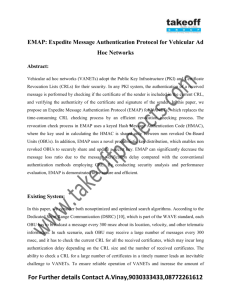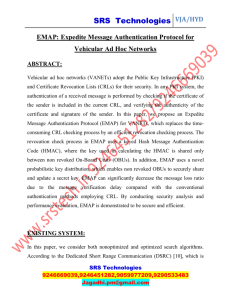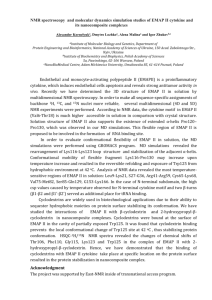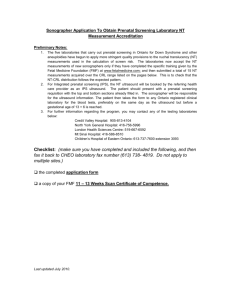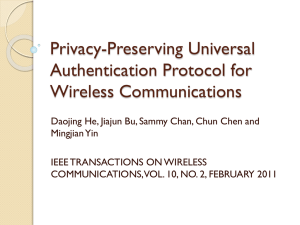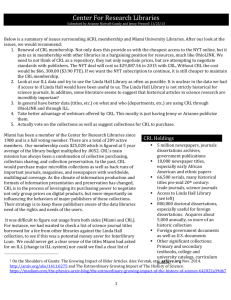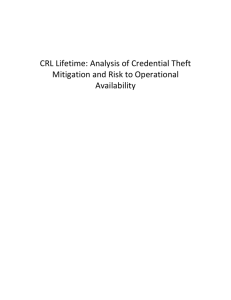EMAP Expedite Message Authentication Protocol for Vehicular Ad
advertisement
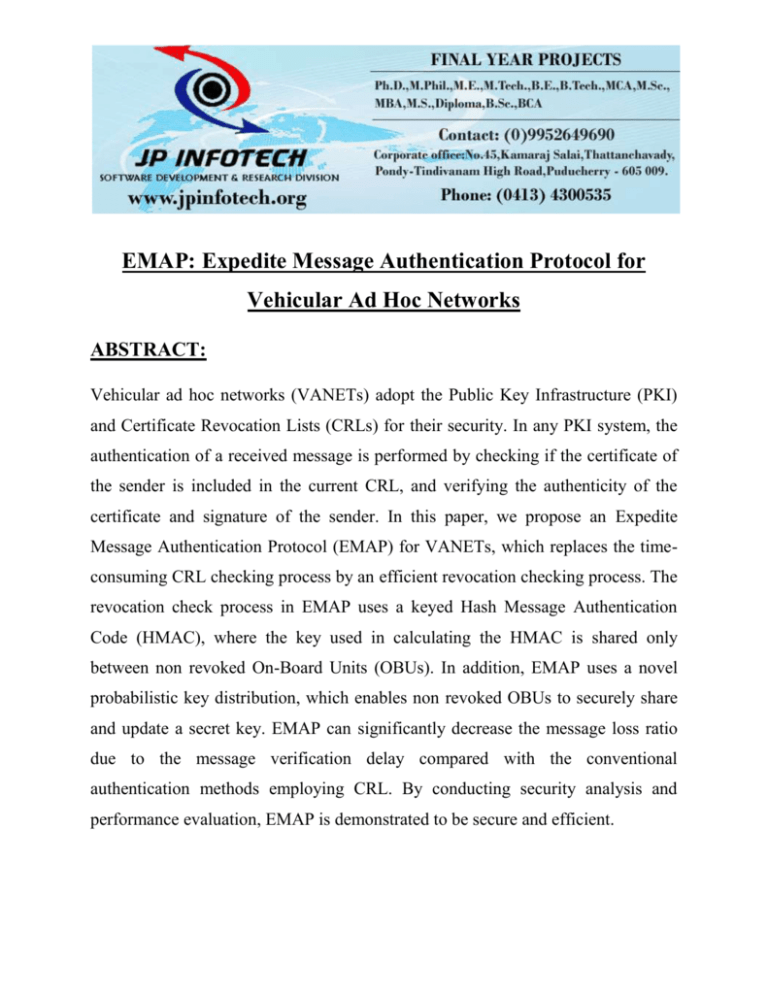
EMAP: Expedite Message Authentication Protocol for Vehicular Ad Hoc Networks ABSTRACT: Vehicular ad hoc networks (VANETs) adopt the Public Key Infrastructure (PKI) and Certificate Revocation Lists (CRLs) for their security. In any PKI system, the authentication of a received message is performed by checking if the certificate of the sender is included in the current CRL, and verifying the authenticity of the certificate and signature of the sender. In this paper, we propose an Expedite Message Authentication Protocol (EMAP) for VANETs, which replaces the timeconsuming CRL checking process by an efficient revocation checking process. The revocation check process in EMAP uses a keyed Hash Message Authentication Code (HMAC), where the key used in calculating the HMAC is shared only between non revoked On-Board Units (OBUs). In addition, EMAP uses a novel probabilistic key distribution, which enables non revoked OBUs to securely share and update a secret key. EMAP can significantly decrease the message loss ratio due to the message verification delay compared with the conventional authentication methods employing CRL. By conducting security analysis and performance evaluation, EMAP is demonstrated to be secure and efficient. EXISTING SYSTEM: In this paper, we consider both nonoptimized and optimized search algorithms. According to the Dedicated Short Range Communication (DSRC) [10], which is part of the WAVE standard, each OBU has to broadcast a message every 300 msec about its location, velocity, and other telematic information. In such scenario, each OBU may receive a large number of messages every 300 msec, and it has to check the current CRL for all the received certificates, which may incur long authentication delay depending on the CRL size and the number of received certificates. The ability to check a CRL for a large number of certificates in a timely manner leads an inevitable challenge to VANETs. To ensure reliable operation of VANETs and increase the amount of authentic information gained from the received messages, each OBU should be able to check the revocation status of all the received certificates in a timely manner. Most of the existing works overlooked the authentication delay resulting from checking the CRL for each received certificate. DISADVANTAGES OF EXISTING SYSTEM: Since vehicles communicate through wireless channels, a variety of attacks such as injecting false information, modifying and replaying the disseminated messages can be easily launched. A security attack on VANETs can have severe harmful or fatal consequences to legitimate users. To abstain the leakage of the real identities and location information of the drivers from any external eavesdropper. The scale of VANET is very large. PROPOSED SYSTEM: In this paper, we introduce an expedite message authentication protocol (EMAP) which replaces the CRL checking process by an efficient revocation checking process using a fast and secure HMAC function. EMAP is suitable not only for VANETs but also for any network employing a PKI system. To the best of our knowledge, this is the first solution to reduce the authentication delay resulting from checking the CRL in VANETs. ADVANTAGES OF PROPOSED SYSTEM: EMAP has the lowest computation complexity compared with the CRL checking processes employing linear and binary search algorithms. The number of messages that can be verified using EMAP within 300 msec is greater than that using linear and binary CRL checking by 88.7 and 48.38 percent, respectively. The proposed EMAP in authentication reduces the end-to-end delay compared with that using either the linear or the binary CRL checking process. SYSTEM ARCHITECTURE: SYSTEM REQUIREMENTS: HARDWARE REQUIREMENTS: System : Pentium IV 2.4 GHz. Hard Disk : 40 GB. Monitor : 15 inch VGA Colour. Mouse : Logitech Mouse. Ram : 512 MB Keyboard : Standard Keyboard SOFTWARE REQUIREMENTS: Operating System : Windows XP. Coding Language : ASP.NET, C#.Net. Database : SQL Server 2005 REFERENCE: Albert Wasef and Xuemin (Sherman) Shen, IEEE, Fellow, “EMAP: Expedite Message Authentication Protocol for Vehicular Ad Hoc Networks”, IEEE TRANSACTIONS ON MOBILE COMPUTING, VOL. 12, NO. 1, JANUARY 2013.
